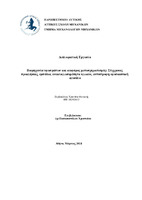| dc.contributor.advisor | Papapostolou, Christiana | |
| dc.contributor.author | Ζερβουδάκη, Χριστίνα-Φωτεινή | |
| dc.date.accessioned | 2024-04-25T07:43:37Z | |
| dc.date.available | 2024-04-25T07:43:37Z | |
| dc.date.issued | 2024-03-19 | |
| dc.identifier.uri | https://polynoe.lib.uniwa.gr/xmlui/handle/11400/6606 | |
| dc.identifier.uri | http://dx.doi.org/10.26265/polynoe-6442 | |
| dc.description.abstract | Η βιομηχανία, συνυφασμένη με την αυξανόμενη κατανάλωση ενέργειας και πόρων, συμβάλλει στην κλιματική αλλαγή και οι συμβατικές μέθοδοι παραγωγής δεν αποτελούν πλέον βιώσιμες λύσεις για την κάλυψη των υλικών αναγκών των ανθρώπων. Η βιομηχανία των υφασμάτων και τον ενδυμάτων διαδραματίζει σημαντικό ρόλο στην ενεργειακή κατανάλωση και καθίσταται σημαντική η καταπολέμηση του προβλήματος αυτού καθώς οι ανάγκες για ένδυση συνεχώς αυξάνονται. Η κλωστοϋφαντουργία περιλαμβάνει την παραγωγή πληθώρας προϊόντων και πρώτων υλών όπως ίνες, νήματα, υφάσματα και ενδύματα. Γίνεται νήματα ατανοητή η υπέρμετρη παραγωγή που πραγματοποιείται ώστε να μπορέσει ο κλάδος αυτός να ανταπεξέλθει στην απαιτούμενη ζήτηση. Η Ευρωπαϊκή Ένωση έχει λάβει μέτρα δημοσιεύοντας επιτρεπτά όρια και οδηγίες αναφορικά με την εισαγωγή της κυκλικής οικονομίας στη βιομηχανία των υφασμάτων. Μέσα από την Βιβλιογραφική Ανασκόπηση που λαμβάνει χώρα στην παρούσα διπλωματική εργασία, παρατηρείται όλο και μεγαλύτερο επιστημονικό ενδιαφέρον γύρω από την ενσωμάτωση βιώσιμων μεθόδων παραγωγής στον συγκεκριμένο κλάδο με την πάροδο των χρόνων. Μέσα από την έρευνα αυτή, εντοπίζονται οι εφαρμοσμένες πρακτικές του αειφόρου μετασχηματισμού σε διάφορα στάδια της παραγωγικής διαδικασίας αλλά και οι προκλήσεις
και τα εμπόδια που προκύπτουν. Επισημαίνεται επίσης πως ο σχεδιασμός των προϊόντων πρέπει να αποτελεί βασική δραστηριότητα καθώς αυτός είναι που προσδίδει τα χαρακτηριστικά στο εκάστοτε προϊόν και καθιστά την παραγωγή και την ανάκτησή του βιώσιμη. Τέλος, αναφέρονται απλοποιημένα εργαλεία που εισάγουν την κυκλική οικονομία στην εφοδιαστική αλυσίδα αλλά και εξελιγμένα τα οποία στοχεύουν σε συγκεκριμένο στάδιο της εφοδιαστικής αλυσίδας. | el |
| dc.format.extent | 129 | el |
| dc.language.iso | el | el |
| dc.publisher | Πανεπιστήμιο Δυτικής Αττικής | el |
| dc.rights | Αναφορά Δημιουργού - Μη Εμπορική Χρήση - Παρόμοια Διανομή 4.0 Διεθνές | * |
| dc.rights.uri | https://creativecommons.org/licenses/by-nc-sa/4.0/deed.el | * |
| dc.subject | Κλωστοϋφαντουργία | el |
| dc.subject | Αειφόρος μετασχηματισμός | el |
| dc.subject | Αντίστροφη εφοδιαστική αλυσίδα | el |
| dc.subject | Βιωσιμότητα | el |
| dc.title | Βιομηχανία υφασμάτων και αειφόρος μετασχηματισμός: Σύγχρονες προκλήσεις, εμπόδια, ανακυκλωσιμότητα υλικών, αντίστροφη εφοδιαστική αλυσίδα | el |
| dc.title.alternative | Textile Industry and Sustainable transformation: Contemporary challenges, material recyclability, reverse supply chain | el |
| dc.type | Διπλωματική εργασία | el |
| dc.contributor.committee | Kavadias, Kosmas | |
| dc.contributor.committee | Κονδύλη, Αιμιλία | |
| dc.contributor.faculty | Σχολή Μηχανικών | el |
| dc.contributor.department | Τμήμα Μηχανολόγων Μηχανικών | el |
| dc.description.abstracttranslated | Industry, intertwined with the increasing consumption of energy and resources, contributes to climate change, and conventional production methods are no longer viable solutions for meeting people's material needs. The textile and clothing industry plays an important role in energy consumption and it becomes important to combat this problem as the needs for clothing are constantly increasing. The textile industry involves the production of a variety of products and raw materials such as fibers, yarns, fabrics and garments. It is understandable that the excessive production is carried out so that this industry can cope with the required demand. The European Union has taken measures by publishing permissible limits and guidelines regarding the introduction of the circular economy in the textile industry. Through the Bibliographic Review that takes place in this thesis, an increasing scientific interest is observed around the integration of sustainable production methods in the specific sector over the years. Through this research, the applied practices of sustainable transformation are identified at various stages of the production process as well as the challenges and obstacles that arise. It is also pointed out that the design of the products must be a basic activity as it is what gives the characteristics to each product and makes its production and recovery sustainable. Finally, simplified tools that introduce the circular economy into the supply chain are mentioned, but also advanced ones that target a specific stage of the supply chain. | el |


